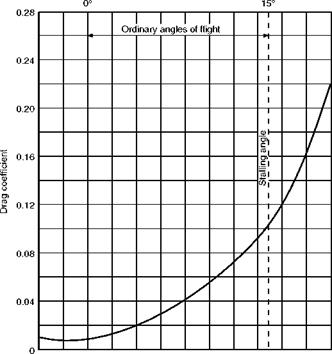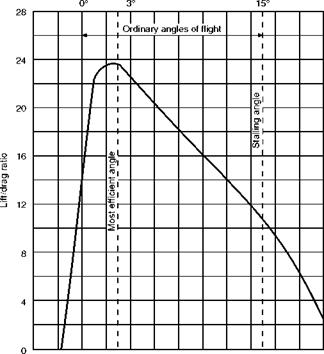The drag curve
Now for the drag coefficient curve (Fig. 3.15, overleaf). Here we find much what we might expect. The drag is least at about 0°, or even a small negative angle, and increases on both sides of this angle; up to about 6°, however, the increase in drag is not very rapid, then it gradually becomes more and more rapid, especially after the stalling angle when the airflow separates.
The lift/drag ratio curve
Next we come to a very interesting curve (Fig. 3.16, overleaf), which shows the relation between the lift and the drag at various angles of attack.
In a former paragraph we came to the conclusion that we want as much lift, but as little drag, as it is possible to obtain from the aerofoil. Now from the lift curve we find that we shall get most lift at about 15°, from the drag curve least drag at about 0°, but both of these are at the extreme range of possible
|
-4° 0° 4° 8° 12° 16° 20° Angle of attack |
Fig 3.15 Drag curve
angles, and at neither of them do we really get the best conditions for flight, i. e. the best lift in comparison to drag, the best lift/drag ratio.
If the reader has available the lift curve and the drag curve for any aerofoil, he can easily plot the lift/drag curve for himself by reading CL off the lift curve at each angle and dividing it by the CD at the same angle. It should be noted that it makes no difference whether we plot LID or CL/CD, as both will give the same numerical value, since L = CL . jpV2 . S and D = CD. jpV2. S.
We find that the lift/drag ratio increases very rapidly up to about 3° or 4°, at which angles the lift is nearly 24 times the drag (some aerofoils give an even greater maximum ratio of lift to drag); the ratio then gradually falls off because, although the lift is still increasing, the drag is increasing even more rapidly, until at the stalling angle the lift may be only 10 or 12 times as great as the drag, and after the stalling angle the ratio falls still further until it reaches 0 at 90°.
The chief point of interest about the lift/drag curve is the fact that this ratio is greatest at an angle of attack of about 3° or 4°; in other words, it is at this angle that the aerofoil gives its best all-round results – i. e. it is most able to do what we chiefly require of it, namely to give as much lift as possible consistent with a small drag.
|
-4° 0° 4° 8° 12° 16° 20° Angle of attack |
Fig 3.16 Lift/drag curve













